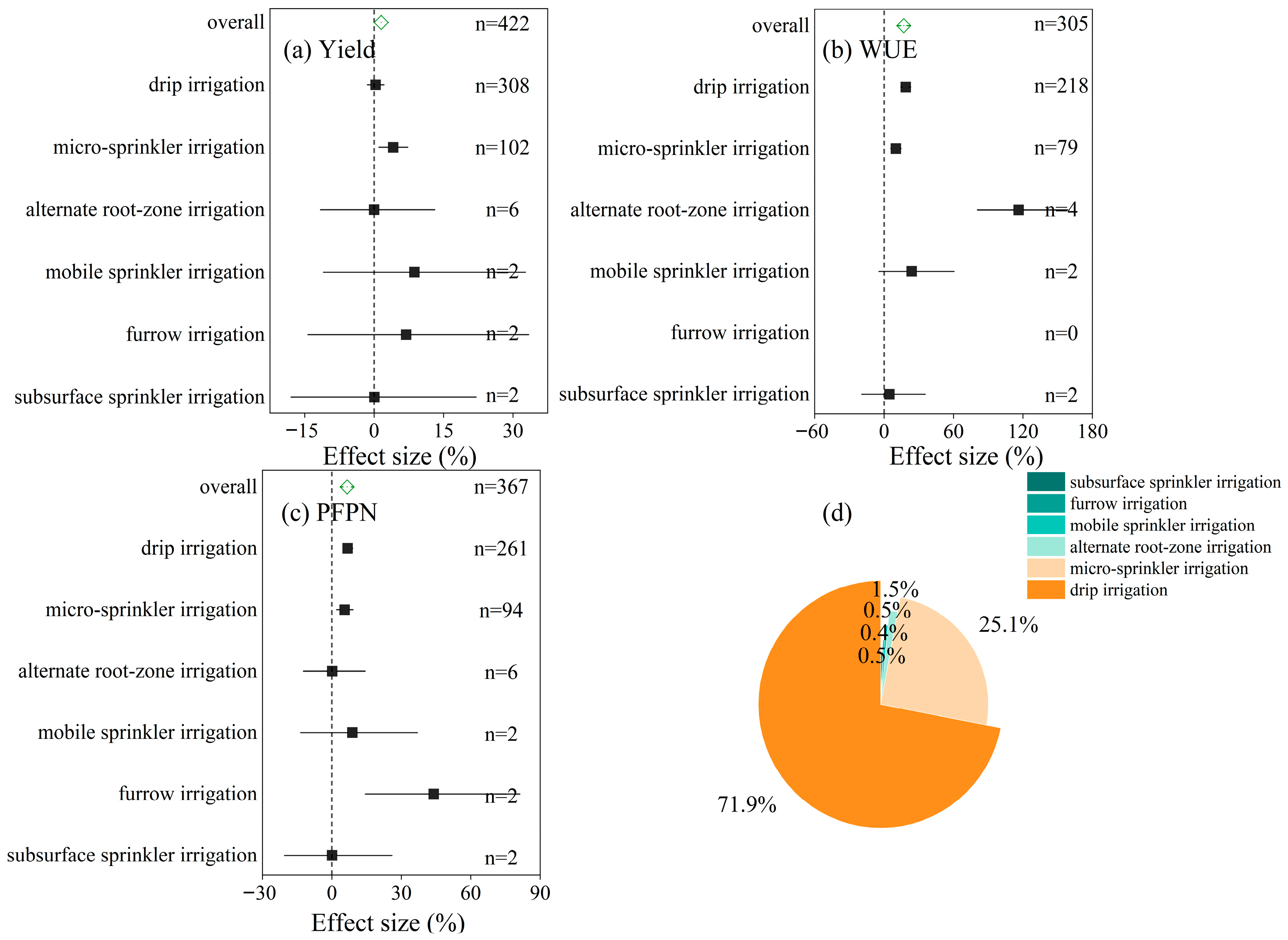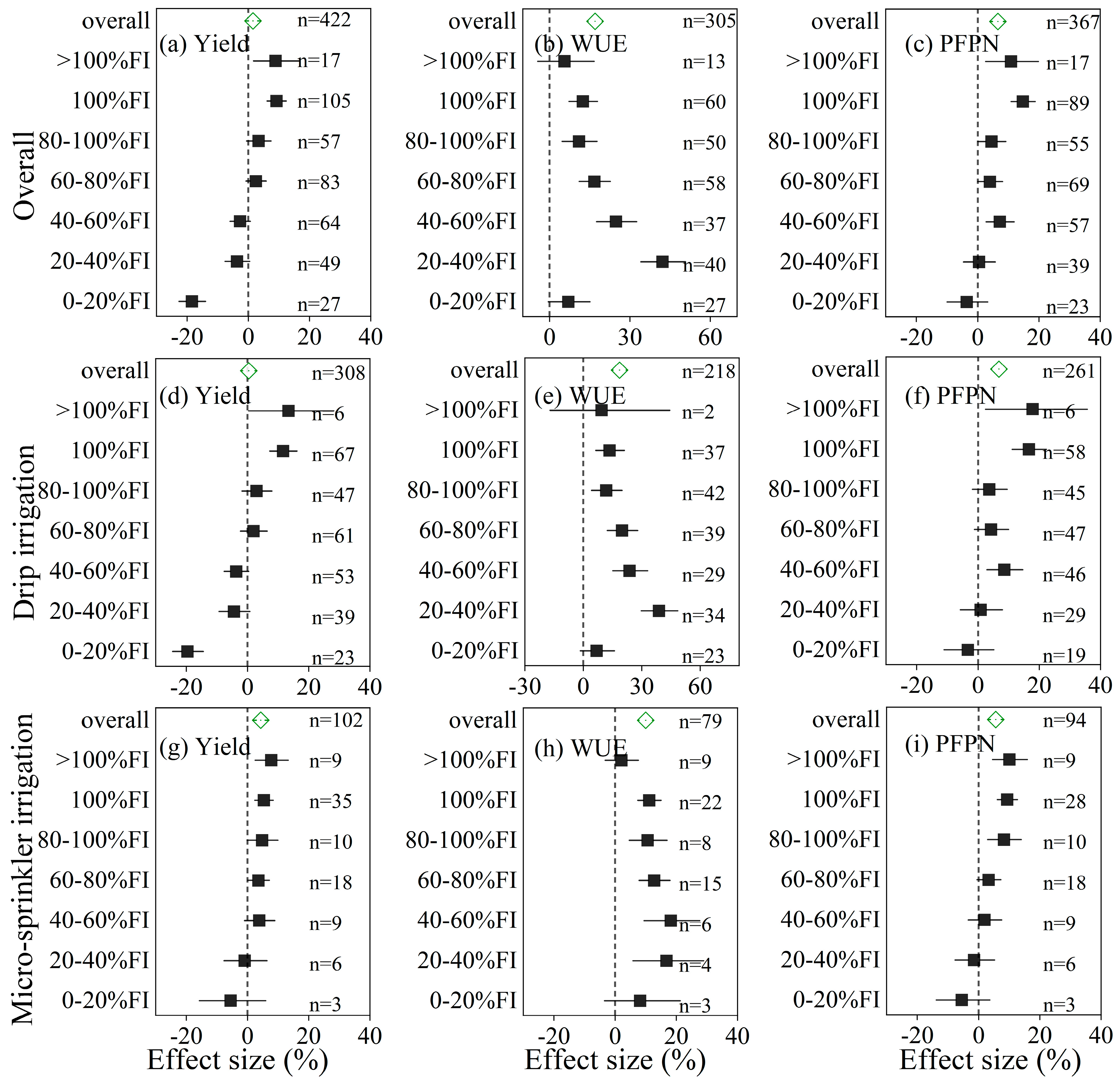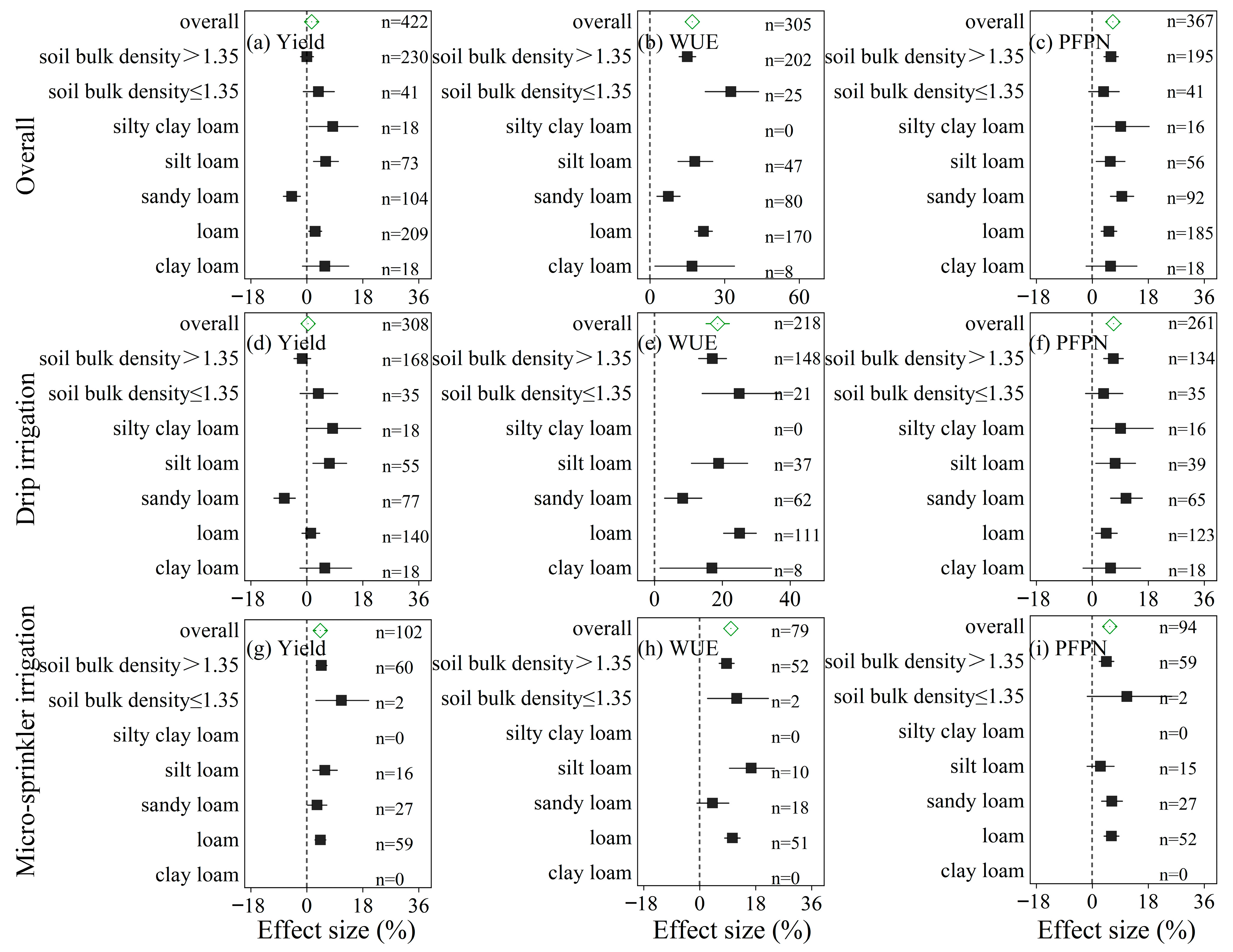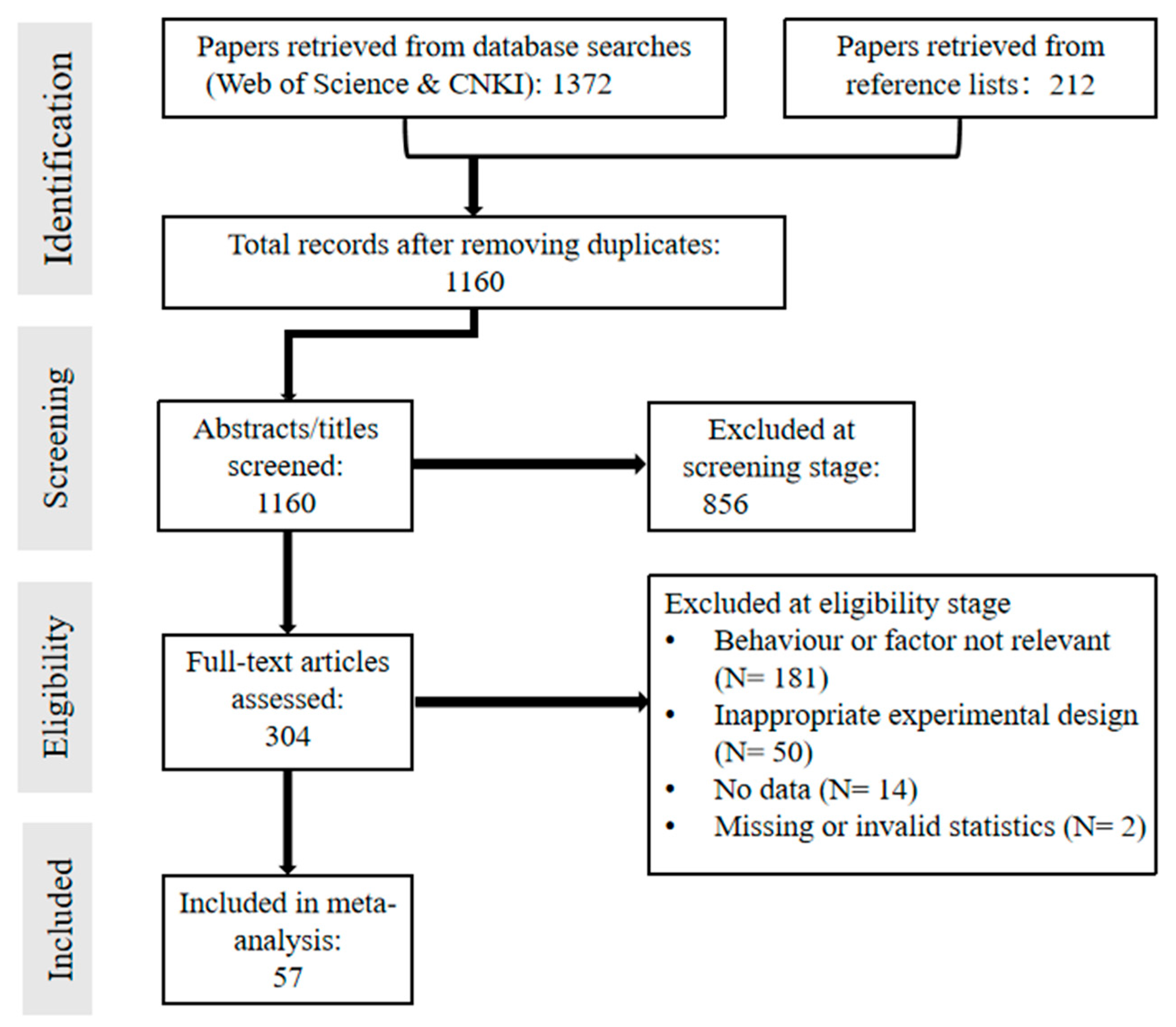Evaluating the Effectiveness of Water-Saving Irrigation on Wheat (Triticum aestivum L.) Production in China: A Meta-Analytical Approach
Abstract
1. Introduction
2. Results
2.1. Effects of Optimized Irrigation on Water and Nitrogen Input Levels
2.2. Effects of Different Water-Saving Irrigation Methods on Wheat Yield, WUE, and Partial Factor Productivity of Nitrogen
2.3. Effects of Irrigation Levels on Wheat Yield, WUE, and PFPN Under Water-Saving Practices
2.4. Differential Responses of Yield, WUE, and PFPN to WSI Under Varying Soil Conditions
2.5. Meta-Regression Analysis of Climatic Factors Affecting Yield, WUE, and PFPN Under WSI
3. Discussion
3.1. Optimized Irrigation Achieves Resource Savings with No Yield Penalty
3.2. WSI Methods Differ in Effectiveness, with Drip and Micro-Sprinkler Irrigation Leading Current Practice
3.3. Moderate Deficit Irrigation Optimizes WUE and PFPN While Avoiding Yield Loss
3.4. Soil Properties Modulate the Agronomic Benefits of WSI
3.5. Climatic Conditions Shape WSI Performance
3.6. Policy Implications for Sustainable Wheat Production in China
4. Materials and Methods
4.1. Data Collection
4.2. Meta-Analysis Procedure
4.3. Model Diagnostics
5. Conclusions
Supplementary Materials
Author Contributions
Funding
Data Availability Statement
Conflicts of Interest
References
- Gong, K.; Rong, L.; Zhang, Y.; Wang, X.; Duan, F.; Li, X.; He, Z.; Jiang, T.; Chen, S.; Feng, H.; et al. Efficient agronomic practices narrow yield gaps and alleviate climate change impacts on winter wheat production in China. Commun. Earth Environ. 2025, 6, 290. [Google Scholar] [CrossRef]
- Chen, B.; Zhang, X.; Gu, B. Managing nitrogen to achieve sustainable food-energy-water nexus in China. Nat. Commun. 2025, 16, 4804. [Google Scholar] [CrossRef]
- Yan, W.; Li, F.; Zhao, Y. Determination of irrigation water quantity and its impact on crop yield and groundwater. Agric. Water Manag. 2022, 273, 107900. [Google Scholar] [CrossRef]
- Yuan, Y.; Lin, F.; Maucieri, C.; Zhang, Y. Efficient Irrigation Methods and Optimal Nitrogen Dose to Enhance Wheat Yield, Inputs Efficiency and Economic Benefits in the North China Plain. Agronomy 2022, 12, 273. [Google Scholar] [CrossRef]
- van Oort, P.A.J.; Wang, G.; Vos, J.; Meinke, H.; Li, B.G.; Huang, J.K.; van der Werf, W. Towards groundwater neutral cropping systems in the Alluvial Fans of the North China Plain. Agric. Water Manag. 2016, 165, 131–140. [Google Scholar] [CrossRef]
- Liang, W.-L.; Peter, C.; Wang, G.-Y.; Lu, R.-H.; Lu, H.-Z.; Xia, A.-P. Quantifying the yield gap in wheat-maize cropping systems of the Hebei Plain, China. Field Crop. Res. 2011, 124, 180–185. [Google Scholar] [CrossRef]
- Huang, X.; Xu, X.; Zhu, Q.; Zhang, Y. Optimizing water and nitrogen inputs for sustainable wheat yields and minimal environmental impacts. Agric. Syst. 2024, 220, 104061. [Google Scholar] [CrossRef]
- Li, J.; Wang, Z.; Song, Y.; Li, J.; Zhang, Y. Effects of Reducing Nitrogen Application Rate under Different Irrigation Methods on Grain Yield, Water and Nitrogen Utilization in Winter Wheat. Agronomy 2022, 12, 1835. [Google Scholar] [CrossRef]
- Yu, Q.; Dai, Y.; Wei, J.; Wang, J.; Liao, B.; Cui, Y. Rice yield and water productivity in response to water-saving irrigation practices in China: A meta-analysis. Agric. Water Manag. 2024, 302, 109006. [Google Scholar] [CrossRef]
- Wu, P.; Wang, Y.; Li, Y.; Yu, H.; Shao, J.; Zhao, Z.; Qiao, Y.; Liu, C.; Liu, S.; Gao, C.; et al. Evaluating optimized irrigation strategies on crop productivity and field water utilization under micro sprinkling irrigation in typical cropping systems of the Huang-Huai-Hai Plain. Eur. J. Agron. 2024, 154, 127093. [Google Scholar] [CrossRef]
- Mehmood, F.; Wang, G.; Abubakar, S.A.; Zain, M.; Rahman, S.U.; Gao, Y.; Duan, A. Optimizing irrigation management sustained grain yield, crop water productivity, and mitigated greenhouse gas emissions from the winter wheat field in North China Plain. Agric. Water Manag. 2023, 290, 108599. [Google Scholar] [CrossRef]
- Wang, Y.; Sun, H.; Wang, L. Optimizing drip irrigation to enhance winter wheat performance: Yield, economic benefits, and water use efficiency. Int. J. Agric. Sustain. 2024, 22, 2437214. [Google Scholar] [CrossRef]
- Hao, T.; Zhu, Z.; Zhang, Y.; Liu, S.; Xu, Y.; Xu, X.; Zhao, C. Effects of Drip Irrigation and Fertilization Frequency on Yield, Water and Nitrogen Use Efficiency of Medium and Strong Gluten Wheat in the Huang-Huai-Hai Plain of China. Agronomy 2023, 13, 1564. [Google Scholar] [CrossRef]
- Li, J.; Xu, X.; Lin, G.; Wang, Y.; Liu, Y.; Zhang, M.; Zhou, J.; Wang, Z.; Zhang, Y. Micro-irrigation improves grain yield and resource use efficiency by co-locating the roots and N-fertilizer distribution of winter wheat in the North China Plain. Sci. Total Environ. 2018, 643, 367–377. [Google Scholar] [CrossRef]
- Fang, Q.; Zhang, X.; Shao, L.; Chen, S.; Sun, H. Assessing the performance of different irrigation systems on winter wheat under limited water supply. Agric. Water Manag. 2018, 196, 133–143. [Google Scholar] [CrossRef]
- Umair, M.; Hussain, T.; Jiang, H.; Ahmad, A.; Yao, J.; Qi, Y.; Zhang, Y.; Min, L.; Shen, Y. Water-Saving Potential of Subsurface Drip Irrigation For Winter Wheat. Sustainability 2019, 11, 2978. [Google Scholar] [CrossRef]
- Li, H.; Li, X.; Mei, X.; Nangia, V.; Guo, R.; Hao, W.; Wang, J. An alternative water-fertilizer-saving management practice for wheat-maize cropping system in the North China Plain: Based on a 4-year field study. Agric. Water Manag. 2023, 276, 108053. [Google Scholar] [CrossRef]
- Ray, D.K.; Gerber, J.S.; MacDonald, G.K.; West, P.C. Climate variation explains a third of global crop yield variability. Nat. Commun. 2015, 6, 5989. [Google Scholar] [CrossRef]
- Wu, Z.; Li, Y.; Wang, R.; Xu, X.; Ren, D.; Huang, Q.; Xiong, Y.; Huang, G. Evaluation of irrigation water saving and salinity control practices of maize and sunflower in the upper Yellow River basin with an agro-hydrological model based method. Agric. Water Manag. 2023, 278, 108157. [Google Scholar] [CrossRef]
- Wang, D.; Liu, S.; Guo, M.; Cheng, Y.; Shi, L.; Li, J.; Yu, Y.; Wu, S.; Dong, Q.; Ge, J.; et al. Optimizing Nitrogen Fertilization and Irrigation Practices for Enhanced Winter Wheat Productivity in the North China Plain: A Meta-Analysis. Plants 2025, 14, 1686. [Google Scholar] [CrossRef] [PubMed]
- Zhao, J.; Xu, X.; Liu, S.; Jia, J.; Li, M.; Huang, H.; Zhang, G.; Zhao, C. Optimizing wheat prosperity: Innovative drip irrigation and nitrogen management strategies for enhanced yield and quality of winter wheat in the Huang-Huai-Hai region. Front. Plant Sci. 2024, 15, 1454205. [Google Scholar] [CrossRef]
- Wu, W.; Liu, M.; Wu, X.; Wang, Z.; Yang, H. Effects of deficit irrigation on nitrogen uptake and soil mineral nitrogen in alfalfa grasslands of the inland arid area of China. Agric. Water Manag. 2022, 269, 107724. [Google Scholar] [CrossRef]
- Rajput, T.B.S.; Patel, N. Water and nitrate movement in drip-irrigated onion under fertigation and irrigation treatments. Agric. Water Manag. 2006, 79, 293–311. [Google Scholar] [CrossRef]
- Li, R.; Ren, F.; Wang, Q. China–US scientific collaboration on sustainable development amidst geopolitical tensions. Humanit. Soc. Sci. Commun. 2024, 11, 1448. [Google Scholar] [CrossRef]
- Liang, Q.; Liu, Y.; Zhang, H.; Peng, Z.; Zhang, X. Sub-surface drip irrigation reduced N2O emissions via inhibiting denitrification pathways in northern China. Appl. Soil Ecol. 2023, 191, 105057. [Google Scholar] [CrossRef]
- Cochard, H.; Coll, L.; Le Roux, X.; Améglio, T. Unraveling the effects of plant hydraulics on stomatal closure during water stress in walnut. Plant Physiol. 2002, 128, 282–290. [Google Scholar] [CrossRef][Green Version]
- Diaz, F.; Jimenez, C.C.; Tejedor, M. Influence of the thickness and grain size of tephra mulch on soil water evaporation. Agric. Water Manag. 2005, 74, 47–55. [Google Scholar] [CrossRef]
- Araguees, R.; Medina, E.T.; Martinez-Cob, A.; Faci, J. Effects of deficit irrigation strategies on soil salinization and sodification in a semiarid drip-irrigated peach orchard. Agric. Water Manag. 2014, 142, 1–9. [Google Scholar] [CrossRef]
- Li, C.; Lei, J.; Zhao, Y.; Xu, X.; Li, S. Effect of saline water irrigation on soil development and plant growth in the Taklimakan Desert Highway shelterbelt. Soil Tillage Res. 2015, 146, 99–107. [Google Scholar] [CrossRef]
- Yue, Z.; Zhuo, L.; Ji, X.; Tian, P.; Gao, J.; Wang, W.; Sun, F.; Duan, Y.; Wu, P. Water-saving irrigated area expansion hardly enhances crop yield while saving water under climate scenarios in China. Commun. Earth Environ. 2025, 6, 295. [Google Scholar] [CrossRef]
- Chiara, C.; Marco, M. Irrigation efficiency optimization at multiple stakeholders’ levels based on remote sensing data and energy water balance modelling. Irrig. Sci. 2023, 41, 121–139. [Google Scholar] [CrossRef]
- Lajeunesse, M.J. Facilitating systematic reviews, data extraction and meta-analysis with the metagear package for r. Methods Ecol. Evol. 2016, 7, 323–330. [Google Scholar] [CrossRef]
- Lajeunesse, M.J. On the meta-analysis of response ratios for studies with correlated and multi-group designs. Ecology 2011, 92, 2049–2055. [Google Scholar] [CrossRef] [PubMed]
- de Graaff, M.-A.; van Groenigen, K.-J.; Six, J.; Hungate, B.; van Kessel, C. Interactions between plant growth and soil nutrient cycling under elevated CO2: A meta-analysis. Glob. Change Biol. 2006, 12, 2077–2091. [Google Scholar] [CrossRef]
- Yu, L.; Zhao, X.; Gao, X.; Siddique, K.H.M. Improving/maintaining water-use efficiency and yield of wheat by deficit irrigation: A global meta-analysis. Agric. Water Manag. 2020, 228, 105906. [Google Scholar] [CrossRef]
- Feng, Z.; Wang, S.; Szantoic, Z.; Chen, S.; Wang, X. Protection of plants from ambient ozone by applications of ethylenediurea (EDU): A meta-analytic review. Environ. Pollut. 2010, 158, 3236–3242. [Google Scholar] [CrossRef]
- Benitez-Lopez, A.; Alkemade, R.; Schipper, A.M.; Ingram, D.J.; Verweij, P.A.; Eikelboom, J.A.J.; Huijbregts, M.A.J. The impact of hunting on tropical mammal and bird populations. Science 2017, 356, 180–183. [Google Scholar] [CrossRef]







Disclaimer/Publisher’s Note: The statements, opinions and data contained in all publications are solely those of the individual author(s) and contributor(s) and not of MDPI and/or the editor(s). MDPI and/or the editor(s) disclaim responsibility for any injury to people or property resulting from any ideas, methods, instructions or products referred to in the content. |
© 2025 by the authors. Licensee MDPI, Basel, Switzerland. This article is an open access article distributed under the terms and conditions of the Creative Commons Attribution (CC BY) license (https://creativecommons.org/licenses/by/4.0/).
Share and Cite
Ma, J.; Yin, B.; Jing, C.; Li, W.; Qiao, Y.; Zhang, L.; Fan, H.; Gu, L.; Zhen, W. Evaluating the Effectiveness of Water-Saving Irrigation on Wheat (Triticum aestivum L.) Production in China: A Meta-Analytical Approach. Plants 2025, 14, 2837. https://doi.org/10.3390/plants14182837
Ma J, Yin B, Jing C, Li W, Qiao Y, Zhang L, Fan H, Gu L, Zhen W. Evaluating the Effectiveness of Water-Saving Irrigation on Wheat (Triticum aestivum L.) Production in China: A Meta-Analytical Approach. Plants. 2025; 14(18):2837. https://doi.org/10.3390/plants14182837
Chicago/Turabian StyleMa, Jiayu, Baozhong Yin, Cuijiao Jing, Wanyi Li, Yilan Qiao, Luyao Zhang, Haotian Fan, Limin Gu, and Wenchao Zhen. 2025. "Evaluating the Effectiveness of Water-Saving Irrigation on Wheat (Triticum aestivum L.) Production in China: A Meta-Analytical Approach" Plants 14, no. 18: 2837. https://doi.org/10.3390/plants14182837
APA StyleMa, J., Yin, B., Jing, C., Li, W., Qiao, Y., Zhang, L., Fan, H., Gu, L., & Zhen, W. (2025). Evaluating the Effectiveness of Water-Saving Irrigation on Wheat (Triticum aestivum L.) Production in China: A Meta-Analytical Approach. Plants, 14(18), 2837. https://doi.org/10.3390/plants14182837





